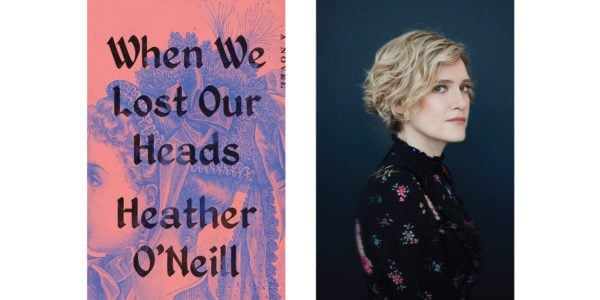
Heather O’Neill (J. Artacho)
In 1967, when Australian author Joan Lindsay’s now-iconic novel Picnic at Hanging Rock was first released, many readers were convinced that her story about a group of female boarding school students who go missing on Valentine’s Day was based on a real-life mystery.
To be fair, the often-adapted novel is structured like a true story, but perhaps the real reason that theory refused to disappear is because many collectively believe that young women are gifted with such mercurial powers that they’re able to make themselves (or others) disappear. Or – as in the case of Heather O’Neill’s latest novel, the fabulous When We Lost Our Heads – to start a revolution.
Although her story might be categorized as historical fiction, O’Neill’s ability to capture the exhilarating danger of female friendship is more reminiscent of Megan Abbott’s women-centred thrillers and, at times, even recalls the 1996 teen witch bonding film The Craft.
O’Neill’s retelling of the French Revolution, set in Victorian-era Montreal (and yes, there is cake), is framed by two young girls, as opposite and similar as two can be. There is Marie Antoine, heir to Canada’s sugar dynasty, whose cherubic silhouette graces each bag of sugar. Marie’s mother died in childbirth, and her father, Louis, obliges her every whim, from her diet of only sweets to her demands for a piglet companion, which she dresses in custom collars and bonnets.
Marie seems happy (or at least tame enough) in her role as leader of the neighbourhood girls until she meets Sadie Arnett, whom she is immediately attracted to for her thick mane of black hair and sombre appearance. The smartest in her class, with a desire not to make friends but to dominate all, Sadie is nonetheless intrigued by Marie’s dramatics, which appear to have sprung to life from one of her beloved novels.
The two outsiders quickly become inseparable, exchanging sugary kisses and poetry recitations. Soon, though, Marie begins to wonder if she is as smart as the adults in her life have enthusiastically proclaimed her to be. Sadie encounters true jealousy for the first time, observing the attention that Marie receives for doing very little. For anyone who has experienced the heady thrills of an all-consuming relationship, O’Neill’s writing, and the set-up of the novel, will ring true: “Every decent friendship comes with a drop of hatred. But that hatred is like honey in the tea. It makes it addictive.”
A deadly accident caused by their natural desire to compete not only separates the two girls physically for most of the novel but also sets in motion a revolt against Marie’s sugar plant and other factories abusing workers’ rights and safety. It is easy to draw connections here to O’Neill’s previous writing, though that line is never direct. Strained familial relationships, illicit erotic tensions, unrealized creative desires, and poverty and class struggles, all swirling around O’Neill’s muse of Montreal, are once again threaded together through a narrative that grounds itself in Sadie’s underworld.
O’Neill is often praised for her world-building and complex explorations of human nature, but not enough kudos are given to the immense amount of research she undertakes to form the invisible scaffolding of her more recent novels and to synthesize her personal curiosities without getting lost in a fairy trail of facts.
If hatred is the honey in the tea, O’Neill’s innate talent for exploring contemporary issues and relationships through page-turning storytelling is the spoonful of sugar that helps the medicine go down.
 Contact us via email
Contact us via email
